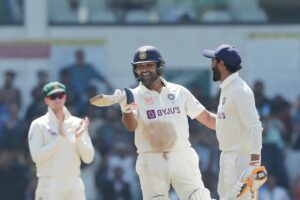
Atreyo Mukhopadhyay
There come times when a batter plays in a zone that sets him or her apart from others. They create a world where everything else appears to be belonging to a different universe. They rule this world like nobody else does, create their rules for the rest to obey. They make every other part of their surroundings their subordinates.
Rohit Sharma was in that zone in India’s first innings in the first Test of the Border Gavaskar Trophy. Wickets tumbling when Australia opted to make first use of a difficult pitch and when his team came out to bat, the India captain batted like a dream. It was one pitch when he was on strike and quite another when others were. We all know this cannot happen, but that’s what he made it look like.
The ball was turning, not really viciously, but more or less all other specialist batters to have batted so far were in discomfort. The bounce was not consistent either. Not unplayable perhaps, but challenging conditions they were, with a number of close-in catchers circling the batters all the time. Rohit, too, was tested. The Australian off-spinners kept bowling from around the wicket with six fielders on the leg-side. A few deliveries from the fast bowlers kept low, making last-second adjustments the only tool of survival. The Mumbai man negotiated everything. It took unwavering focus and concentration other than high levels of batting skills.

Batters in general and Rohit in particular, are remembered for the shots they play. They produce strokes on a regular basis which others do occasionally. The India skipper is known for all that, his timing and his innate ability to ‘see the ball early and hit it late’ — words used decades ago by CLR James to describe a fellow Trinidadian who could not make it to the top level. In addition, Rohit has worked on his defensive game. This was evident in Nagpur in the way he handled deliveries that kept low, blunted the spinners without using his pad, the soft hands he patted the ball with.
Nagpur, incidentally, is a special venue for Rohit. He was born in a place called Bansod near the city. It was at the VCA Stadium in 2017 against Sri Lanka that he registered his third Test century, four years after hitting two in his first two Tests. He has only got better since, making most of the opportunity to open the innings. In 19 Tests as opener, he averages 57.65. Six of his nine centuries have come when he took on the new ball.
One can say Rohit’s performance in SENA countries is not that impressive. He averages 15.37 from four Tests in South Africa, 42.36 in six in England, 40.66 in two in New Zealand and 31.38 in seven outings in Australia. The 127 at The Oval in 2021 remains his only century in these countries, where batting is considered to be a tough proposition for batters from the subcontinent. The game changes when it comes to India, where he averages 75.20 from 21 Tests.

But these are mere numbers. What matters at the end of the day is the impact a player makes, how much his efforts contribute to the team’s cause, how it affects the outcome of a match. Against England in Chennai in 2021, happened something similar to what has been seen in Nagpur in the ongoing Test. That was also a turning track and India were desperate for a win after having lost the first Test. Rohit rose to the occasion with a towering 161 in a first-innings total of 329. India went on to win the Test and the series.
But Nagpur posed a different challenge. Expectations of Rohit have increased manifold, he is not just a senior batter but also the captain. Responsibilities are greater. He has to lead by example, curb his natural instincts, eschew the urge to be flamboyant, play according to the need of the hour and look ugly if need be. In short, the situation possibly demanded a personality change. That’s easier said than done for a person turning 36 in April and that’s what he has done.
India owe their position of strength in this Test also to Ravindra Jadeja, Axar Patel and Ravichandran Ashwin. However, if one takes out Rohit’s innings, the hosts would find themselves in a precarious position. That’s the real value of the Rohit rhapsody which came off 212 balls, after nearly three session of vigil. In the context of the match, taking into account the importance of the series, quality of the opposition and nature of the pitch, this was invaluable.




